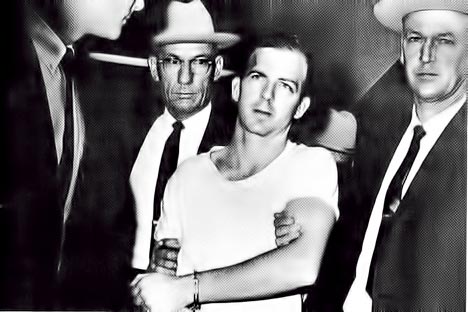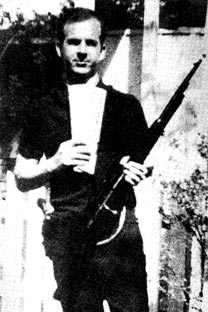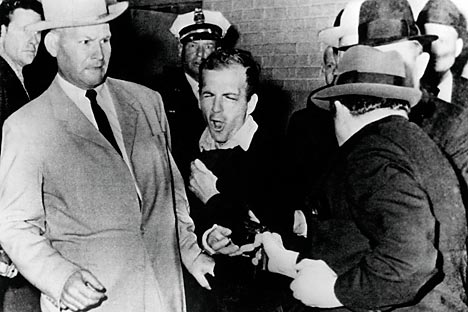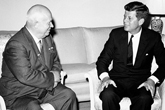Oswald and the Soviet connection

Lee Harvey Oswald in detention. It seemed that he would be brought to justice thanks to the work of the FBI, but even their capable hands couldn't protect him from Jack Ruby. Source: Photos from the book Three Bullets for the President by Oleg Nechiporenko
Oleg Nechiporenko, retired intelligence service colonel, knew the man who shot US President John F. Kennedy. Shortly before the tragedy, when he was working at the Soviet embassy in Mexico under diplomatic cover, he talked with Lee Harvey Oswald, who had come to apply for a visa. After retiring, Nechiporenko became a writer, and some of his books about the assassination of President Kennedy became bestsellers. RIR talks to the man who kept a tab on the notorious assassin.
Oleg Maksimovich, it has been 50 years since the day Oswald climbed onto a school textbook warehouse and fired three bullets at John F. Kennedy. So many conspiracy theories have arisen. There's the one about American oil barons who plotted to stop Kennedy from bothering them, the plots of Cuban ultras, and even the schemes of the Soviet secret police. And Oswald was just a scapegoat, as he called himself in front of television cameras. It's time to reveal the secrets.
 |
| A photograph of Oswald in his backyard in Dallas. The photo was taken by his Russian wife, Marina. Source: Photos from the book Three Bullets for the President by Oleg Nechiporenko |
I have my own opinion on this story. I do not agree that he was a “scapegoat,” unlike some of my former colleagues from intelligence.
Let's start with the simple facts. After all, Oswald, who went to the USSR on a tourist visa and asked for political asylum in 1959, was well known by the KGB.
Do you think it is all so “simple?” I worked on a book about the incident and studied the files on Oswald for years.
So the KGB had files on Oswald?
What do you think? Six bulky files covering the two and a half years that he lived in the Soviet Union. Just imagine - the year was 1959, a severe iron curtain had been drawn between the two countries, and then suddenly a former Marine declares himself a Marxist, wants to help build a socialist society, and requests Soviet citizenship. The case was extremely rare and caused a reaction in the highest ranks. The KGB was involved in it too.
Figuratively speaking, the security services had Oswald “under a microscope?”
Without even speaking figuratively, he was under a microscope from his first day in the USSR as a tourist, October 16, 1959, to the day of his departure in May 1962. Back then two KGB divisions handled foreign tourists. The First Chief Directorate (PGU) was interested in recruiting possible candidates to be foreign agents. The Second Chief Directorate - counterintelligence - identified secret agents of the enemy.
But Oswald was ahead of the game. Already on the second day after arriving in the Soviet Union, he asked his guide Rimma S. to help him fill out an application for Soviet citizenship.
And that Rimma S. was your agent?
Almost all the Intourist employees worked with us. Such were the times. And the American's petition, he was immediately given the code name “Nalim” (burbot in Russian), was examined and considered by the KGB, military intelligence, foreign affairs, the visa office, Intourist, and the Red Cross. The decision to reject the application for citizenship was made by Foreign Minister Gromyko, Chairman of the KGB Semichastny, and comrade Anastas Mikoyan himself, who oversaw international issues in the government and the Central Committee of the party.
Oswald caused a big stir
There was a terrific ripple effect. There were so many organizations that got involved in this business! I must say that his energy was amazing. When his application hit a snag, he managed to pester everyone and everything. And he didn't even know Russian. He wrote letters, begged, and when his citizenship application was denied, he tried to commit suicide.
I had not heard that before
He cut his veins, ended up in Botkin Hospital. But he didn't make the cut very deep, just frightened us a bit with a little blood. And then everyone, including the KGB, realized that Oswald was not your average petitioner. If he set himself a goal, he would not give up. Do you understand? No matter what happened to him. What if he would really try to commit suicide? Then the whole world would have heard about it: man of leftist leanings dreams of Soviet citizenship, is denied, and is driven to kill himself. The West would have had a field day. They decided not to give him citizenship, just granted temporary residence on the territory of the USSR.
Was Oswald a Soviet agent?
Never. No one even attempted to recruitment him. He was a persona non grata for our special services. Moreover, they had doubts about him, did not rule out the possibility that he was spying for the Americans. And when he moved to Minsk, they were happy to hand him over to the Belarus KGB. As former KGB Chairman Semichastny recalled in a conversation with me, “they performed routine surveillance of Oswald, using agents, operational equipment, field surveillance ...”

May 23, 1962: Lee and Marina Oswald the day they left Minsk. Source: Photos from the book Three Bullets for the President by Oleg Nechiporenko
Why did they move him to Minsk?
They wanted to send him to the Baltic states, but Oswald absolutely refused. It was hard to get him to agree to Minsk. But he moved, he went to work in a radio factory as a low rank controller, and the Center lost interest in him.
It must have been hard for Oswald to live on a low rank controller's income.
Don't worry about him. The Central Committee of the CPSU issued him 5000 roubles through the Red Cross, they gave him a salary of 700 roubles, and he got a free apartment.
}
Not bad! That was a lot of money back then. But Oswald decided to leave for the United States.
He turned out to be lazy. He worked in a slipshod manner. As for Marxism - he was not interested in anything. He didn't learn Russian. But he did go to all the parties, loved girls, married 20-year-old Marina Prusakova. That's all of his achievements. In Minsk they didn't even keep him under serious surveillance. They got a feeling that he was thinking about leaving, so why risk exposing people. But when there were difficulties with leaving, he again displayed extraordinary energy and resourcefulness. It was found that, contrary to his claims, he had not given up his US citizenship. He left with Marina, his young wife from Minsk, who had borne him a child, and everyone breathed a sigh of relief. That egotistic and nervous guy cost us a lot and was so useless. After he left, the conclusion was unanimous: “During the entire time Oswald was under our surveillance there was no evidence that he had any association with U.S. intelligence agencies.”

Oswald screams after being shot by Ruby. Source: Photos from the book Three Bullets for the President by Oleg Nechiporenko
Could a man like Oswald have acted alone in killing the US president? Think of all the American security; and he was even a bad shooter.
He could have killed him alone. And who told you that Nalim was a bad shooter? Back in Minsk he bought a single-shot hunting rifle that he would use sometimes when he went hunting. And in the States he obtained a rifle too.
Oleg, you were one of the three employees of the Soviet Embassy in Mexico City who spoke with Oswald when Nalim applied for a Soviet visa shortly before the assassination of Kennedy in Dallas. Why did you refuse him? What alarmed you?
After Kennedy's assassination, the Americans found our papers refusing his request to enter the USSR. Can you imagine what a mess that would have been if we had granted him a visa? On September 27, 1963, Lee Oswald came to the embassy. At the beginning of the conversation he was kind of distracted, but then he concentrated. He talked about his life in Minsk, about marrying a Soviet citizen. He explained his desire to go back to the USSR was due to the fact that he was under constant surveillance by the FBI. He spoke with irritation, then with excitement. He seemed to be a very neurotic man. Of course, Oswald was under our control in Minsk, but the thought of possibly collaborating with him did not arise over our hour-long conversation.
Why?
He was not suitable for operational activities. He spoke Russian but mispronounced words, his pronunciation was terrible, and sometimes he switched to English. He had a second conversation at the embassy with two of my colleagues. They, too, thought he seemed neurotic, which he actually turned out to be.
So how did he manage to kill Kennedy?
In short, he just got incredibly lucky. But for Kennedy, for America, for us, it was terribly tragic. On November 22, 1963, he chose one of the most suitable places on the route of the presidential motorcade - Dealey Plaza in Dallas - from which to aim at the president. There are two turns here: one was a 90 degree turn, and for the second the motorcade had to make a 120 degree turn. Oswald worked in the book warehouse right on the motorcade route. He could enter the building freely and hide his rifle with telescopic sight in advance. And, surprisingly, the buildings along the route were not inspected by the police, because the Secret Service usually did not require such searches. In order to understand the situation better, I have consulted with Russian law enforcement agencies in this research. Their leader confirmed the choice was perfect. And he, too, thought a schoolbook warehouse made a good shelter, where the shooter had an opportunity to fire accurately with a support. This greatly improves shooting accuracy. The angle of the shot and the target, along with the slope of the street, made it easier to ambush the motorcade.
Do I understand correctly that even an average sniper would not have missed?
Yes. And experts also believe that all of these conditions would have reduced the need for the shooter to have any special training. It is safe to say that high efficiency firepower is enough for even a middle-class shooter. Oswald's three bullets reached their target.
All rights reserved by Rossiyskaya Gazeta.
Subscribe
to our newsletter!
Get the week's best stories straight to your inbox

